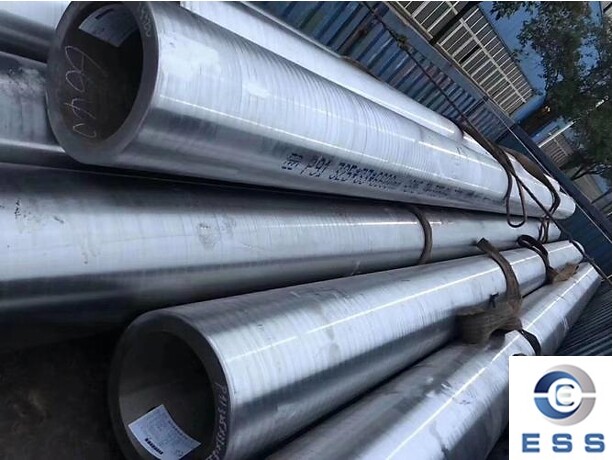
Carbon steel seamless
pipe is a widely used pipe material. Due to their high strength and stable
mechanical properties, they are widely used in petrochemical, construction,
aerospace, manufacturing and other fields. In order to further improve the
performance and quality of carbon steel seamless pipes, annealing treatment is
often required. Annealing treatment is a heat treatment method that can change
the crystal structure and properties of metal materials by slowly increasing
the temperature and cooling after reaching a certain temperature.
The annealing conditions of carbon steel
seamless pipes are a key issue that directly affects the quality and
performance of the product. The following are the relevant return conditions:
Temperature conditions
1. Full annealing
Full annealing is to heat the carbon steel
seamless pipe to 30-50℃ above the critical temperature
(Ac3). For carbon steel with a carbon content of 0.3%-0.6%, the Ac3 temperature
is roughly 750-800℃, which means that the full
annealing temperature is usually 800-850℃. At this
temperature, all ferrite and cementite in the steel are recrystallized, the
grains are refined, and the structural defects are eliminated. For example, in
actual production, the hardness of the steel pipe can be reduced by complete
annealing, thereby improving the cutting performance.
2. Incomplete annealing
The incomplete annealing temperature is
above the critical temperature (Ac1) and below Ac3. Taking hypoeutectoid carbon
steel as an example, the Ac1 temperature is about 727℃,
and the incomplete annealing temperature can be set at 740-770℃. This annealing method is mainly used to refine the grains and
reduce the hardness while maintaining a certain strength and toughness. It can
improve the internal structure of the steel pipe to a certain extent, laying
the foundation for subsequent processing.
3. Spheroidizing annealing
Spheroidizing annealing is mainly for
eutectoid and hypereutectoid carbon steels, and its temperature is generally
20-30℃ above Ac1. For example, for T10 steel with a
carbon content of about 1.0%, the Ac1 temperature is about 730℃, and the spheroidizing annealing temperature can be controlled at
750-760℃. The purpose of spheroidizing annealing is to
spheroidize cementite, reduce hardness, improve cutting performance, and
prepare for subsequent heat treatments such as quenching.
Holding time
The holding time refers to a process in
which the pipe is kept at this temperature for a certain period of time after
reaching the annealing temperature so that it can reach a uniform grain size.
The length of the holding time is also determined by the specific material,
wall thickness and requirements of the product. Generally speaking, the holding
time is generally about 2-4 hours.
Cooling method
1. Complete annealing
After complete annealing, the cooling speed
should be slow, generally cooling to 500-600℃ with the
furnace and then air cooling out of the furnace. Such slow cooling can fully
decompose the austenite during the cooling process, forming a balanced ferrite
and pearlite structure, and avoiding the generation of large internal stress.
For example, during the cooling process, the stress inside the steel pipe is
released due to the uniform temperature drop, thus ensuring the quality of the
steel pipe.
2. Incomplete annealing
The cooling rate after incomplete annealing
is also relatively slow, and furnace cooling or burying in sand cooling is
usually adopted. The furnace cooling rate can be controlled at 30 - 50℃/h until it cools to a lower temperature. This cooling method can
make the organizational transformation more uniform and reduce internal stress.
Through slow cooling, the internal structure of the steel pipe gradually
stabilizes, providing good conditions for subsequent processing.
3. Spheroidizing annealing
The cooling rate after spheroidizing
annealing also needs to be controlled. Generally, after the end of the
insulation, it is cooled to 500 - 600℃ at a rate of 10
- 20℃/h, and then air-cooled out of the furnace. This
cooling method helps to maintain the spheroidization effect of cementite, so
that the steel pipe can obtain good mechanical properties and cutting
performance.
Atmosphere conditions in the furnace
During the annealing process, the
atmosphere in the furnace is crucial. Generally, a neutral atmosphere or a
slightly oxidizing atmosphere is used. If the reducing atmosphere in the
furnace is too strong, it may cause decarburization on the surface of the steel
pipe, affecting its surface quality and performance. For example, when
annealing in a gas furnace, the ratio of gas and air needs to be controlled to
avoid producing too much reducing gas. At the same time, too much oxidizing
atmosphere will cause the surface of the steel pipe to oxidize and form oxide
scale, so the atmosphere in the furnace should be adjusted reasonably.
Furnace loading method
Carbon steel seamless pipes should be
placed evenly when loading the furnace to avoid mutual squeezing to ensure
uniform temperature in the furnace. Too dense loading will cause uneven heating
of the steel pipe and affect the annealing effect. Generally, layered loading
or interval loading is adopted. The loading position is reasonably arranged
according to the size and shape of the steel pipe so that each steel pipe can
be fully heated and cooled.
Summary
Therefore, the selection of annealing
conditions for carbon steel seamless pipes is of great significance to the
quality and performance of the product. The temperature, insulation time,
cooling method and atmosphere must be reasonably selected according to the
specific product requirements to ensure that the product meets the required
performance and quality requirements.













 Eastern Steel Manufacturing Co.,Ltd not only improve product production and sales services, but also provide additional value-added services. As long as you need, we can complete your specific needs together.
Eastern Steel Manufacturing Co.,Ltd not only improve product production and sales services, but also provide additional value-added services. As long as you need, we can complete your specific needs together.










